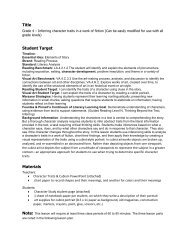1017-teaching-drama-in-the-classroom
1017-teaching-drama-in-the-classroom
1017-teaching-drama-in-the-classroom
Create successful ePaper yourself
Turn your PDF publications into a flip-book with our unique Google optimized e-Paper software.
SARAH KAPLANSTARTING FROM SCRATCH: CREATING DYNAMICCHARACTERSINTRODUCTIONI have found that students are much more engaged <strong>in</strong> learn<strong>in</strong>g if <strong>the</strong>y have apersonal connection to <strong>the</strong> subject matter. When I ask my students to createcharacters, <strong>the</strong>y often don’t know where to beg<strong>in</strong>, so I started us<strong>in</strong>g a methodof character creation that allows <strong>the</strong>m to beg<strong>in</strong> with <strong>in</strong>formation that <strong>the</strong>y know:characteristics of <strong>the</strong>mselves. While I use this lesson <strong>in</strong> my Act<strong>in</strong>g classes, itcould certa<strong>in</strong>ly be used <strong>in</strong> any language arts class as an <strong>in</strong>troductory activity tocharacter development. The goal is that each student will generate a list of nounsthat relate to his life and adjectives that describe him. He will <strong>the</strong>n give that list toano<strong>the</strong>r student who will create a first-person character monologue from <strong>the</strong> listof words. Students enjoy this activity, because <strong>the</strong>y have a clear prompt to workfrom when <strong>the</strong>y are do<strong>in</strong>g <strong>the</strong> writ<strong>in</strong>g, and <strong>the</strong>y end up with characters that arebased on <strong>the</strong>mselves. They love see<strong>in</strong>g <strong>the</strong> characters that <strong>the</strong>ir classmates <strong>in</strong>ventfrom <strong>the</strong> details of <strong>the</strong>ir lives.PROCEDURE1. Ask each student to fold a piece of paper “hotdog style” (vertically). Studentsshould not put <strong>the</strong>ir names on <strong>the</strong>ir papers, but <strong>the</strong>y should put <strong>the</strong>ir gender.2. Each student should write ten nouns that relate to him <strong>in</strong> column one. Thesecan be descriptive nouns (friend, son, sister, scholar, actor, athlete or materialitems such as cell phone, runn<strong>in</strong>g shoes, IPOD, peanut butter).3. Each student should write ten adjectives that describe him <strong>in</strong> column two.4. The teacher collects each paper and <strong>the</strong>n re-distributes <strong>the</strong>m so that eachstudent has a new paper that IS NOT his or hers.5. The students should create a monologue <strong>in</strong> first-person voice of a characterbased on <strong>the</strong> 20 words on <strong>the</strong> page. They should be true to <strong>the</strong> gender. Theymust give <strong>the</strong> character a name and, of course, an age. They do not need to useall (or any) word from <strong>the</strong> orig<strong>in</strong>al writer. We are NOT look<strong>in</strong>g for a re-list<strong>in</strong>gof <strong>the</strong> words. What we want is a creative character based on <strong>the</strong> adjectives andnouns provided, but, of course, students can add <strong>the</strong>ir own details, as long as<strong>the</strong>y make sense <strong>in</strong> comparison to <strong>the</strong> 20 words provided. The characters canbe of any age, from any location, and with any job.J.K. Dowdy and S. Kaplan, Teach<strong>in</strong>g Drama <strong>in</strong> <strong>the</strong> Classroom, 15–16.© 2011. Sense Publishers. All rights reserved.



